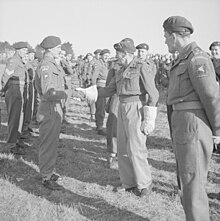6th Airborne Division
The 6th Airborne Division ( German 6. Luftlandedivision ) was an airborne division of the British Army , which was formed during World War II and existed until 1948.
The division was established in the United Kingdom on May 3, 1943 and consisted of paratrooper and glider units. The number 6 was chosen to give the impression that there are five other airborne divisions. In fact there were only two - the 1st and 6th Airborne Divisions. Famous members of the division were Major John Howard , Lieutenant-Colonel ( Lieutenant Colonel ) Terence Otway , Lieutenant John Hollington Grayburn , and Lieutenant Den Brotheridge , the first fallen Allied soldier on D-Day .
The division captured key positions for the invasion of Normandy during Operation Tonga in 1944 , fought during the Battle of the Ardennes and took part in the Rhine crossing in March 1945 . After the war, the members of the division were deployed in Palestine , among other places .
history
Second World War
D-Day
In the last hours of June 5, 1944 landed units of the division, which had been transported by airplanes and gliders, in the course of Operation Tonga , in Normandy , behind the beach area Sword at which the next day, June 6, the D -Day , British troops should land. The task of the British 6th Airborne Division was to secure the eastern flank of the troops landing on June 6th. These included, among others, the conquest of the Pegasus and Horsa Bridge , which is a part of the D Company , under the command of Major John Howard had to fulfill, and the destruction of the artillery battery at Merville , the 9th battalion, under the command by Lieutenant-Colonel ( Lieutenant Colonel ) Terence Otway . The two units that had to perform these tasks were some of the first units to land in Normandy. On the morning of June 7th, at around 1 p.m., the 1st Command Brigade under Lord Lovat advanced to Howard's troops. Although the landings had been extensively tested, many units were dispersed in Normandy. The area of the Pegasus and Horsa Bridge was successfully defended against the Germans until, after the Germans had launched many counter-attacks, the Allied troops were relieved of parts of the British 3rd Infantry Division on the evening of June 6th .
On June 12th the British artillery bombed Bréville during the attack . A grenade hit a group of British officers . Lieutenant-Colonel Johnny Johnson was killed and Brigadier Kindersley and Lord Lovat were seriously injured.
From June to August the division successfully defended the area east of the Orne River . On August 2, 1944, the 6th Airborne Division became part of the Allied 1st Airborne Army . In mid-August the division participated in the advance towards the Seine and returned to the UK early in September 1944 to recover and regroup. The division had lost 4,000 men, either dead, wounded, or missing.
The battle in the Ardennes
On December 16, 1944, the Germans launched the Ardennes Offensive , a final attempt at attack against the Allies in the Ardennes . The 6th Airborne Division pushed into Belgium shortly after helping to repel the attack . The fighting lasted until mid-January 1945 in very bad weather conditions.
Crossing the Rhine
On March 24, 1945, the division took part in the air crossing of the Rhine ( Operation Varsity ), which took place the day after the Rhine was crossed by ground troops ( Operation Plunder ). However, the Germans had expected the division, which resulted in the division suffering heavy losses in the air and on the ground. The operation was still a success, but paid for at a high price. Then the 6th Airborne Division pushed northeast towards the Baltic Sea until it met Red Army units on May 2, 1945 on the eastern outskirts of the port city of Wismar .
End of war
On May 8, 1945, the Second World War in Europe ended with the unconditional surrender of the Wehrmacht . For parts of the division, however, the war continued elsewhere. The 5th Paratrooper Brigade was sent to the Far East in July 1945 with the intention of allowing the rest of the division to follow suit to take part in the campaign against the Japanese . After the atomic bombs were dropped on Hiroshima and Nagasaki in August 1945, Japan saw no way out but unconditional surrender. On August 15, Japan surrendered and on September 2, World War II officially ended with the signing of the Japanese surrender .
post war period
With the end of the war there was no longer any combat mission in the Far East. The 5th Brigade was still on duty in Malaysia and Singapore to disarm the Japanese armed forces. The brigade then went to Java , where it stayed until the Royal Dutch Army reached the island in 1946.
The division was then transferred to Palestine , where it was supposed to provide internal security. It moved into its headquarters in Beit Hadar in Tel Aviv. It remained there until April 1948 when it was disbanded. A total of 58 men were killed in Palestine. Another 236 men were wounded while stationed in Palestine.
Insignia
The shoulder piece of the 6th Airborne Division (as well as that of the 1st) was created by Major E. Seago and introduced in May 1942. It consisted of a red-brown square with a sky-blue winged horse, the mythical Pegasus , in the middle.
Commanders
- Richard Gale (May 7, 1943)
- Eric Bols (December 8, 1944)
- James Cassels (1946)
- Hugh Stockwell (August 1947)
Film adaptations
- The division's role during Operation Tonga is portrayed in the 1962 war film The Longest Day .
literature
- Christopher Chant: Operation Overlord. Sword Beach & the British 6th Airborne Division, 6 June 1944 (= Ravelin's Order of Battle Series. Volume 1). Ravelin, Braceborough 1994, ISBN 1-898994-00-5 .
Individual evidence
- ↑ Tom Segev: Once upon a time there was a Palestine. Jews and Arabs before the founding of the state of Israel. Pantheon, Munich 2006, ISBN 3-570-55009-5 , p. 526 f.
Web links
- The division in Palestine ( English )
- 6th-airborne.org ( English )




